
(English Translation by Spinner 8 and Friends)
Ganbare Goemon! Karakuri Dōchū (roughly translated as, “Go For It, Goemon! A Tricky Journey”) is the first home console entry in the beloved, long running Ganbare Goemon series. Being that this is the first time I’ve talked about Goemon on the blog, I should probably mention Ishikawa Goemon who serves as the historical inspiration for the character. Basically any time this series is mentioned in print, the name of Ishikawa Goemon will inevitably be invoked like a talismanic spirit, drifting somewhere between legend and pixel. So in keeping with this hallowed tradition, I shall henceforth pretend that I’m presenting you with new and fascinating information, while you, in turn, shall pretend to be impressed by this erudite bit of video game trivia (that you’ve already read about in every other article written about Ganbare Goemon). This is the custom and we must play our roles. I’ll try to keep it brief, because this dude had a pretty wild life, much of which is couched in folklore and legend. Ready?

Ahem … Ishikawa Goemon, upon whom the character of Goemon is based, was a semi-legendary outlaw said to have lived during Japan’s Azuchi-Momoyama period (in the late 16th century). Variously described as having been a (mystical) ninja or a thief, he’s basically Japan’s version of Robin Hood in that he redistributed stolen wealth back to the poor. As legend has it, he was also not completely averse to a well-meaning assassination plot here and there. One story even tells of Goemon attempting to assassinate the legendary warlord Oda Nobunaga … which, had he been successful, almost certainly would have put an end to Nobunaga’s ambition and saved us from a dreadfully boring video game series of that same name. At any rate, it was Goemon’s ambitions as a would-be assassin that eventually sealed his fate. After another failed (and more widely agreed upon as factual) assassination attempt against the warlord Toyotomi Hideyoshi, he was caught and sentenced to death. Ishikawa Goemon and his young son(!) were boiled alive together in a giant cauldron on the banks of the Kamo River in Kyoto. Perhaps if Toyotomi Hideyoshi hadn’t been such a spiteful dick, he too would have gotten a series of video games bearing his name (dreadfully boring or otherwise).
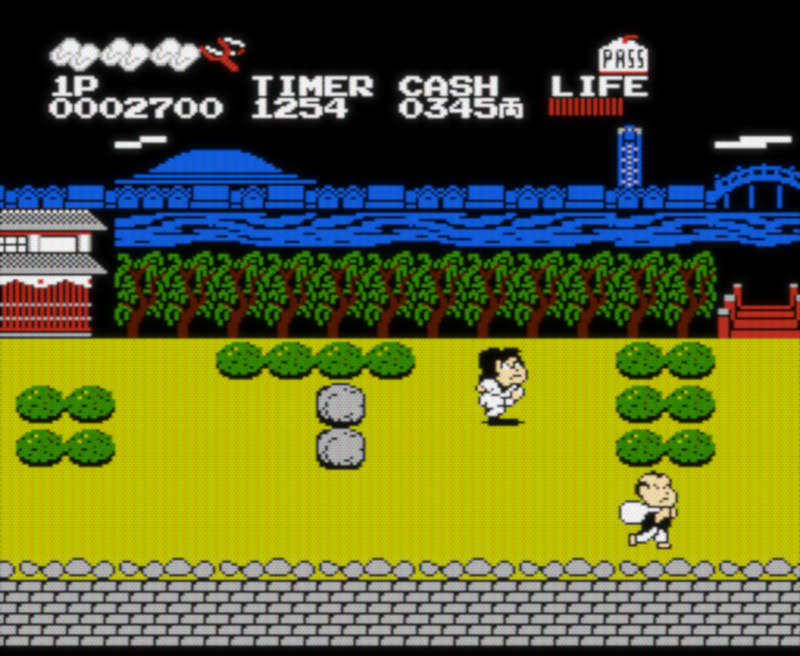
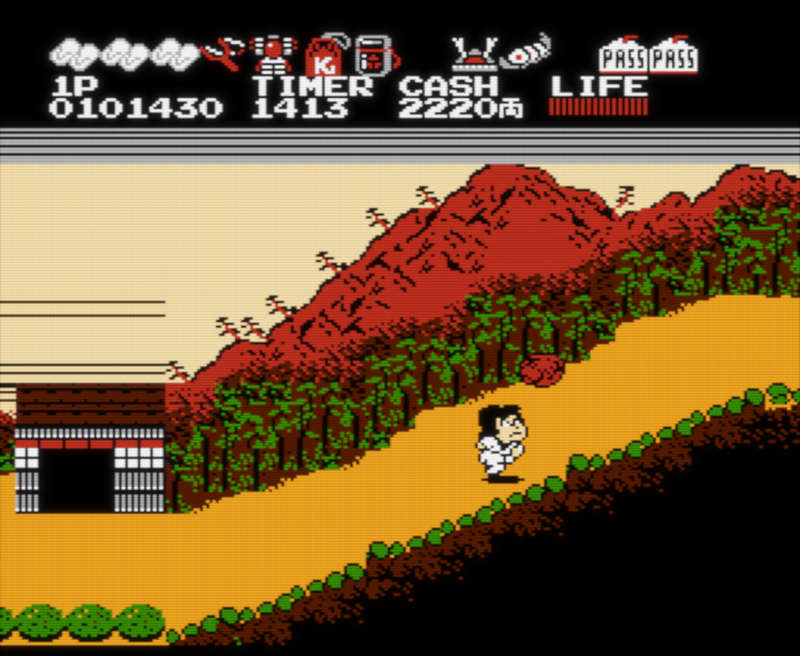
As time went on Goemon became a folk hero and fixture of Japanese theater, eventually celebrated as a charismatic national symbol of rebellious spirit and guile. Among other things his legend is the subject of many classic Kabuki plays in which he’s often depicted as smoking a kiseru pipe. Heck even today you can bathe in a giant cauldron shaped bathtub called a goemonburo (literally “Goemon bath”), because one should always consider the possibility of being boiled alive while in the midst of an otherwise peaceful spa day. At any rate, the legend of (the mystical ninja) Goemon would eventually intersect with the cultural zeitgeist of video games, first in a Konami produced arcade game called Mr. Goemon, and subsequently in this game, Ganbare Goemon! Karakuri Dōchū, which was released for Famicom in 1986, and never (officially) outside of Japan.

Generally we kick things off by delving into plot details, but in this case … we’ve kind of already done that? Basically, Goemon is travelling through the historic Higo Province of Japan (an area which is now encompassed by the Kumamoto Prefecture on the island of Kyūshū). I suspect each level of the game is loosely based on actual regions within the province, but that’s purely guesswork. The in-game map indicates that Goemon’s final destination is a feudal castle with several levels in between. A quick bit of research tells me that the traditional castle city of Higo province was Kumamoto … which was invaded and conquered by our old friend Toyotomi “boil’em alive” Hideyoshi in 1586. Oh. Is this game … not going to end well for Goemon? Well apparently Hideyoshi bestowed the castle to a loyal retainer named Katō Kiyomasa, so perhaps we don’t need to start heating up the caldron just yet. I’m making up and filling in a lot of story details here, because what’s provided in-game is pretty sparse (perhaps the manual filled those missing details). In short, Goemon is travelling through the Higo province, presumably to stick it to that fat cat daimyo living the high life in his bougie castle. In each level Goemon needs to collect three passes in order to be granted passage to the next region (hey, Goemon may be a legendary outlaw, but defying the requirements of proper travel documentation is a line even he’s not willing to cross). At the end of each level you’re presented with a scene of Goemon running through the streets in the middle of the night throwing gold to the common folk. While the Ganbare Goemon series would eventually develop its own quirky trademark sense of humor and an outlandish cast of characters, Karakuri Dōchū plays it fairly straight. There are moments of humor, but for the most part this game seems to represent Goemon’s historical adventures rather than fantastical tales of ghost maidens, ninja cats, giant mecha, and the like which would all appear in later series entries.
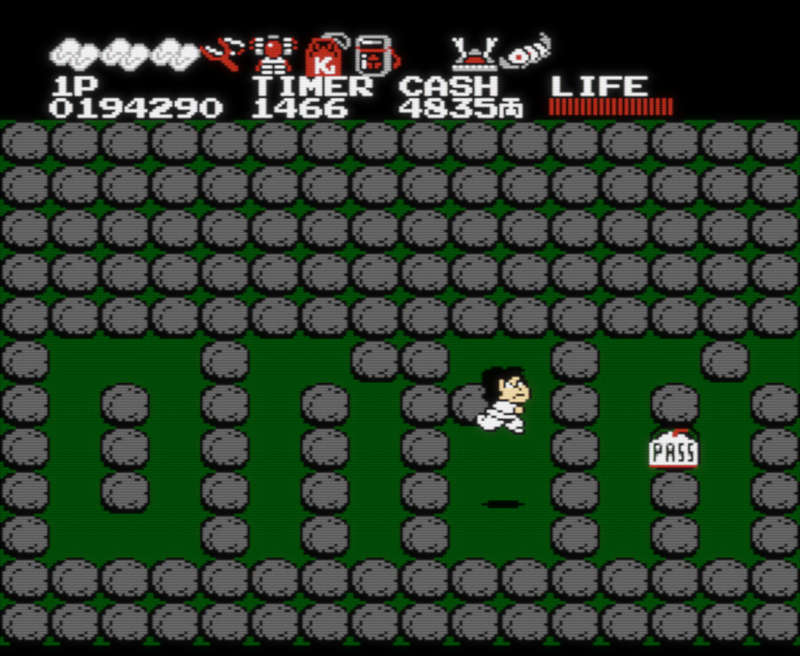

In the U.S., our introduction to Ganbare Goemon was by means of The Legend of the Mystical Ninja released for SNES, which was actually the fourth game in the series (or the fifth if we count that arcade game). What’s interesting about Karakuri Dōchū is that many of the barebones mechanics found in the SNES release are present right here from the start of the series. Basically Karakuri Dōchū is a ¾-perspective, free-roaming beat ’em up with a heavy emphasis on exploration. As mentioned above Goemon must collect 3 passes in order to advance through each stage. Finding those passes is where the exploratory elements come to bear. Each stage is loaded up with hidden underground areas where these passes can often be found. Locating the hidden areas can be tedious though. In order to find the entrance to a hidden passage, you must first jump over the entrance spot at which point the entrance is revealed. The mechanics of doing so are easy of course, it’s just jumping over ‘the spot’. But systematically canvassing each of the sprawling, labyrinthine levels with an organized campaign of jumping over every other pixel quickly becomes an exercise in drudgery. Meanwhile as you’re orchestrating that campaign, the timer continues to tick down. Oh, did I mention there’s a timer? Yeah … I’ve talked about my feelings regarding this particular design choice before. <steps up on soapbox> If you’re designing a game in which exploration is a key element, why the hell would you impose a time limit!? “Oops you didn’t explore everything fast enough!” is such a baffling design choice to me. Dear Game Designers of the 1980’s … choose between a time limit -or- in-depth exploration; you don’t get both. If you do implement both for some baffling reason, then at least signpost the important exploratory elements, even if only subtly. <steps off soapbox> It seems like it’s almost always Konami games I call out for this. At any rate, Karakuri Dōchū doesn’t signpost those hidden entrances whatsoever. Enjoy all that jumping. (To be faaair, you can occasionally find an item which reveals all the hidden entrances in a given level … so you can go ahead and stow that whining, null. Sincerely Yours, the Game Designers of the 1980’s).

Beyond that quibble, Ganbare Goemon! Karakuri Dōchū is fairly fun and innovative. While you’re hunting down those elusive passes, you’ll also collect gold which can be used to purchase a wide variety of helpful items and power-ups from the many shops to be found. If you’re feeling lucky, you can also gamble away that gold in casinos if you like. Sometimes the NPCs will just say random funny bits when you enter their residence. In each level you’ll also eventually find a building in which a secret passageway can be opened for a price. Upon paying up, you’re able to enter a first-person labyrinth, dungeon-crawler style. These labyrinths range from fairly simple to surprisingly large and complex by the end of the game. First person dungeon crawling elements were en vogue during this era, and while Karakuri Dōchū doesn’t break any radical new ground in this capacity, these segments introduce a nice change of pace to the game (it’s certainly a break from all that jumping around). In point of fact, you have to explore these areas, as one of those precious passes will always be found in each level’s first-person labyrinth. Thankfully the timer is put on hold while you do so.
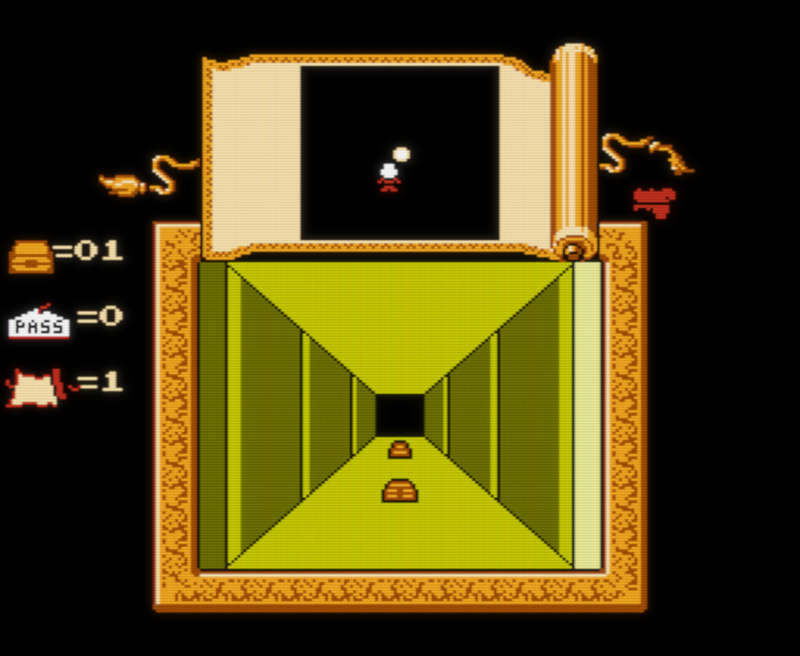
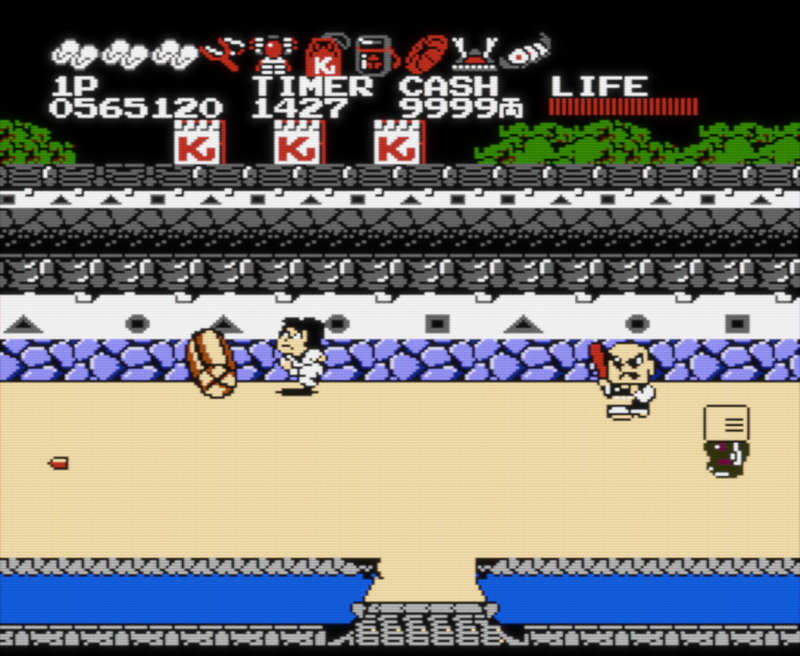
Presentation elements are quite good for a game of this era. Karakuri Dōchū features thirteen sizeable levels and the graphical variations between each level are quite impressive. Rather than lazy palette swaps, each level feels like its own distinct region. This has an overall effect of world building, insofar as conveying a convincing 8-bit version of feudal Japan. It’s not often I’d apply the term ‘immersive’ to a game of this vintage (and it might be a slight stretch even here), but Karakuri Dōchū really does score some high marks in this regard. The music is well composed and catchy, but can get repetitive after a while, what with the random, time-consuming nature of the exploration.
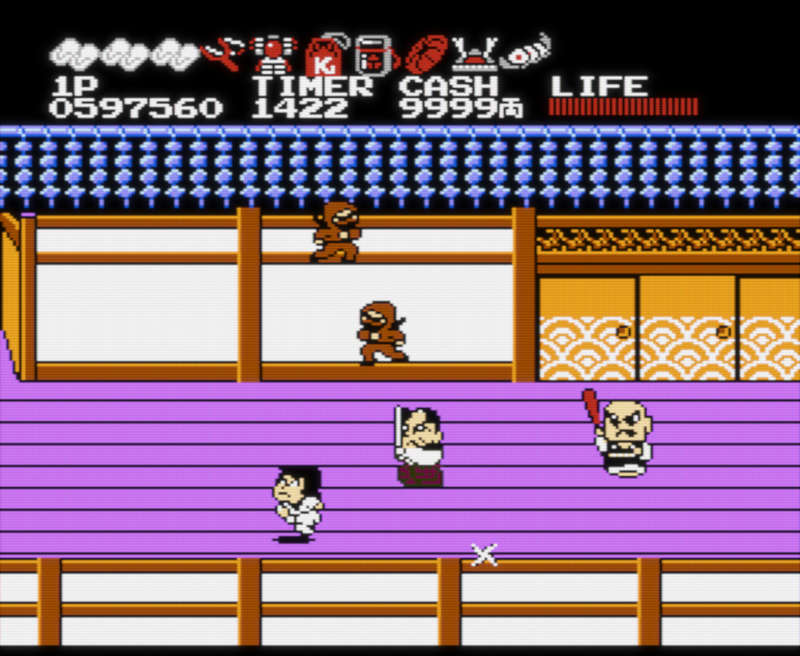
Ganbare Goemon! Karakuri Dōchū certainly lives up to its translated title as a ‘Tricky Journey’, but often the ‘tricky’ bits are manifested as an extended exercise in patience due to the confounding nature of its exploratory elements. That being said, it still comes together as a satisfying gaming experience which ultimately exceeds the sum of its parts. It’s easy to see how the compelling elements here lent themselves to a series that would go on to greatness. I’m going to qualify my final judgement on this one only to recommend online maps if you find yourself stuck looking for those elusive passes. There’s no point becoming bogged down by tedium. Ultimately Karakuri Dōchū is still worth playing though, particularly if you’re looking to delve into the roots of the Ganbare Goemon series. It’s also one of the essentials for anyone interested in exploring Japanese exclusives for the Famicom. For my part I’m certainly looking forward to further adventures with Goemon.
Final Verdict: 7 hidden passages out of 10 random jumps
Leave a Reply